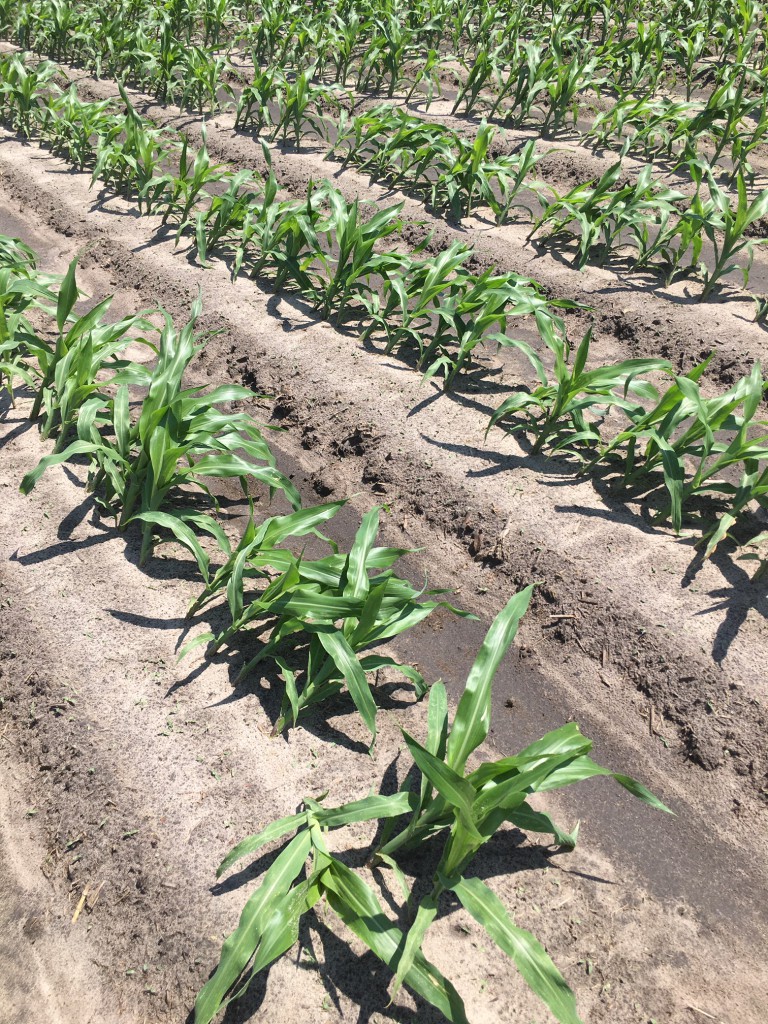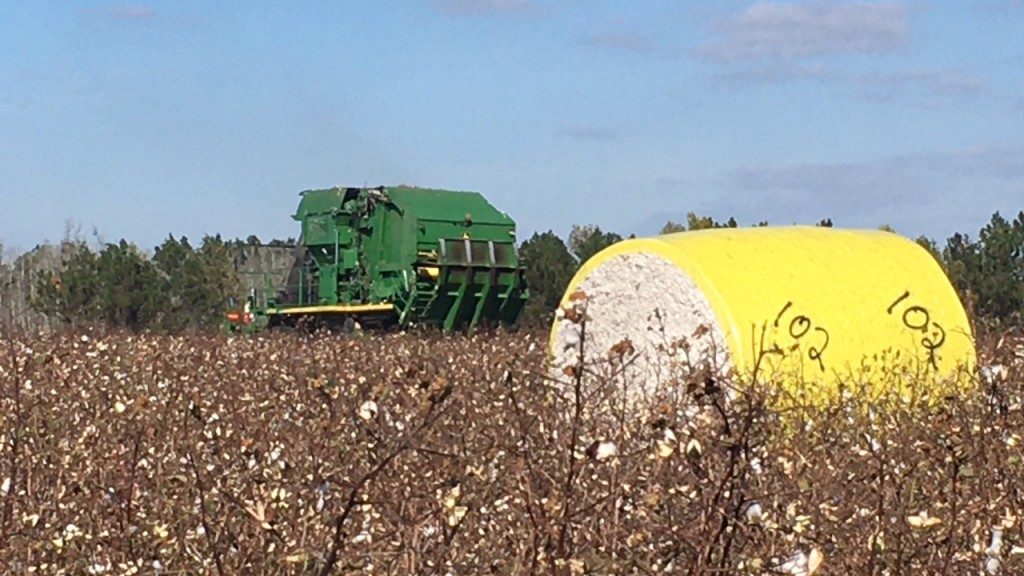Below are common questions that I have been receiving from area producers..
How do I control volunteer peanuts in field corn? According to the 2020 UGA Corn Production guide, volunteer peanut plants can be one of the most difficult weeds to control in field corn. Peanut plants are sensitive to POST applications of glufosinate (Liberty), split applications of glyphosate (Roundup), or dicamba (Clarity, Engenia, Fexapan, Status, Xtendimax). Lay-By/PDIR applications of ametryn (Evik) may also provide some control.
My corn has blown down? I have received a couple of calls about wind damaged corn after heavy rain events we received over the last week. (Week of April 6-13) According to Dr. Corey Bryant, UGA Small Grains Agronomist, there are three main problems we want to watch for following severe wind events. These issues include greensnap, root lodging, and pinching.

Wind damaged corn in Colquitt County last week..
Greensnap is when the plant breaks at some point along the mainstem. This is most likely to occur in plants that have reached or exceeded the V8 growth stage, but should still be scouted for in younger plants. Most often, plants that have “greensnap” may not recover and potential yield losses may be correlated to the percent stand reduction.
Root lodging from strong winds is most often found in plants that have surpassed the V13 growth stage and are nearing tassel. The roots on the windward side of the plant will be uprooted/exposed while the roots on the opposite side of the plant will be buckled below the soil surface. While this issue tends to effect more mature/heavier corn plants it should not be completely ruled out in younger corn plants. Past research has shown that root lodged plants can recover vertical growth, through “goosenecking”, without significant yield loss if the damage occurs no later than 10 days prior to tasseling.
Pinching is similar to greensnap but instead of actually breaking, the mainstem folds, or pinches. Corn plants will remain alive and can recover upright growth but yield loss may occur due to decreased efficiency in nutrient and water flow within the plant.
What about summer annual forages?
Pearl millet can be grazed or harvested as hay or silage. It is a medium to high yielding summer annual forage and is more productive in drought conditions. Planting can begin when the 2 inch soil temperature reaches 65 degrees F. Seed can be broadcasted (25-30 lbs of PLS/Acre) or drilled (10-15 lbs of PLS/Acre). The seeding depth needs to be around ½ to 1 inch deep. Pearl millet can tolerate lower soil pH than sorghums and is very responsive to nitrogen.
Growers can begin to graze pearl millet once the plants reach 20 to 24 inches, but regrowth rate and animal performance is best if a 9 to 12 inch stubble height is maintained. Pearl millet tillers well, making it very suitable for grazing.
Pearl millet can make good quality hay if cut when plants reach 2 to 3 feet tall. This prevents the forage from maturing beyond the boot stage and therefore being too mature to provide high quality. The drying rate of millet hay can be sped up if a roller/crimper-style conditioner is used.
If harvested prior to advanced maturity stages, the range of total digestible nutrients (TDN) can be expected to be 52 to 58 percent, while crude protein (CP) will range from 8 to 11 percent. There is some evidence to suggest that seeding rates at the high end of the recommended ranges will promote a higher leaf:stem ratio. This may improve forage quality, but these gains may not compensate for the expense of the higher seeding rate.
Pearl millet has one major advantage over sorghum, sudangrass, and sorghum x sudangrass hybrids in that it does not produce prussic acid. This advantage allows pearl millet to be grazed or harvested at any growth stage and during droughts without the risks associated with prussic acid poisoning. However, pearl millets can have high nitrate levels similar to other warm season sorghums. Horses may suffer from subclinical and acute prussic acid poisoning, so species in the sorghum family should not be fed to them.
Sorghum x sudan hybrids have the highest yield potential of the summer annual forages if adequate rainfall or irrigation is received. However, sorghum x sudan yields are more severely affected by drought than pearl millet and are less tolerant of poor soil conditions and soil pH values less than 5.8. Seed can be broadcasted (20-25 lbs of PLS/Acre) or drilled (15-20 lbs of PLS/Acre). Sorghum x sudans can be used for grazing or silage, but like other annual sorghums, their forage is difficult to dry to moistures suitable for hay production.
Sorghum x sudan hybrids should be rotationally grazed, allowing the forage to reach 24 inches before grazing (i.e., managed like sudangrass). This species can be harder to manage in a grazing situation due to the fact it does not tiller as well as other summer annual species. This property can impact recovery time if sorghum X sudan is grazed too hard. Sorghum x sudans will generally have TDN values in excess of 53 to 60 percent and CP concentrations of 9 to 15 percent. Brown midrib (BMR) varieties are usually preferred varieties for grazing or conserved forage since they have less lignin and higher digestibility than other varieties.
Sudangrass has finer stems, tillers profusely and is leafier than forage sorghums. They produce very few seed. When compared to other sorghums, the growth rate is better after a cutting or a grazing event. This growth characteristic makes it a great candidate for rotational grazing. They tend to have less prussic acid accumulation than forage sorghums, and these levels tend to decrease with maturity. Sudangrass seed can be broadcasted (30-40 lbs of PLS/Acre) or drilled (20-25 lbs of PLS/Acre).
Photoperiod-sensitive sorghum x sudan and forage sorghum cultivars are available. These varieties are capable of sustaining more consistent growth over a longer growing season because they remain in a vegetative stage late into
September (until daylength is less than about 12 hours and 20 minutes). This trait may negate or lessen the need for staggered plantings.
Forage sorghum is a high yielding summer annual forage. They may contain 0 to 50 percent grain in the forage depending on the hybrid and stage of maturity at harvest. As plants mature, lignification can increase which results in reduction in forage quality. Forage sorghum have thick stems that make hay production difficult but makes excellent silage. Nutritive value is often times 85 to 90 percent of corn silage. Highest crude protein and digestibility will usually be obtained when harvested in a vegetative stage of growth but dry matter production can be increased as plants mature. Harvesting in the late grain dough stage will maximize TDN. Forage sorghum seed can be broadcasted (20-25 lbs of PLS/Acre) or drilled (15-20 lbs of PLS/Acre).
How do I sample my hay and baleage ??
I have been getting questions about forage sampling over the last couple of weeks. Producers have been challenged establishing their winter annual forages this past fall and the feeding of hay has increased in local herds. Forage quality is only a guess unless you test. In order for a cattle or forage producer to obtain the best results from a test please collect a representative sample by following these guidelines: Test each lot of forage separately. A “lot” is defined as hay that was harvested at the same time, out of the same field, and under the same conditions. *If part of the field was rained on before baling – sample rained on bales as a new lot. Please remember that a forage analysis is only as good as the sample collected. Below is information about forage testing from UGA Forages.
Dry Hay
1. Using a hay coring probe, collect 15-20 cores from each lot.
2. Insert the hay probe on the side of the bale, coring towards the center so you cross several windrows.
3. Remove the hay probe and empty the contents into a clean container (i.e. bucket or bag).
4. Mix the material thoroughly to decrease bias. Pour in enough sample material to fill up a 1-quart plastic bag.
5. Label each sample with a self-imposed sample ID to make it easy to remember the lot sampled.
6. Fill out the UGA Feed and Forage Testing Application, attach the form to the sample, and submit via the UGA County Extension Office.
Baleage
Baleage samples may be collected at multiple times:
* Post baling – before wrapping: collect core samples just prior to wrapping, using the dry hay protocol.
*After wrapping: collect core samples from various locations in the tube or from several individually wrapped bales from the same lot. Ideally this would occur post fermentation (6+ weeks post-wrapping).
*Just prior to feeding: collect core samples from the tube or lot of bales that you plan to feed next. This decreases potential spoilage due to hole punctures over a prolonged time period.
When sampling baleage:
1. Seal the puncture hole immediately after coring with and “X” using a UV protected silage tape.
2. Remove as much air from the sample bag as possible prior to sealing.
3. Ship baleage samples to the lab immediately and early in the week to re-duce the chance of spoilage between collection and analysis.
